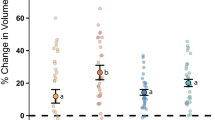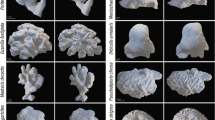Abstract
Size and growth rates for individual colonies are some of the most essential descriptive parameters for understanding coral communities, which are currently experiencing worldwide declines in health and extent. Accurately measuring coral colony size and changes over multiple years can reveal demographic, growth, or mortality patterns often not apparent from short-term observations and can expose environmental stress responses that may take years to manifest. Describing community size structure can reveal population dynamics patterns, such as periods of failed recruitment or patterns of colony fission, which have implications for the future sustainability of these ecosystems. However, rapidly and non-invasively measuring coral colony sizes in situ remains a difficult task, as three-dimensional underwater digital reconstruction methods are currently not practical for large numbers of colonies. Two-dimensional (2D) planar area measurements from projection of underwater photographs are a practical size proxy, although this method presents operational difficulties in obtaining well-controlled photographs in the highly rugose environment of the coral reef, and requires extensive time for image processing. Here, we present and test the measurement variance for a method of making rapid planar area estimates of small to medium-sized coral colonies using a lightweight monopod image-framing system and a custom semi-automated image segmentation analysis program. This method demonstrated a coefficient of variation of 2.26 % for repeated measurements in realistic ocean conditions, a level of error appropriate for rapid, inexpensive field studies of coral size structure, inferring change in colony size over time, or measuring bleaching or disease extent of large numbers of individual colonies.




Similar content being viewed by others
References
Bak, R. P. M., & Meesters, E. H. (1998). Coral population structure: the hidden information of colony size-frequency distributions. Marine Ecology Progress Series, 162, 301–306.
Barott, K., Smith, J., Dinsdale, E., Hatay, M., Sandin, S., & Rohwer, F. (2009). Hyperspectral and physiological analyses of coral-algal interactions. [Research Support, Non-U.S. Gov’t]. PloS One, 4(11), e8043. doi:10.1371/journal.pone.0008043.
Bongiorni, L., Shafir, S., Angel, D., & Rinkevich, B. (2003). Survival, growth and gonad development of two hermatypic corals subjected to in situ fish-farm nutrient enrichment (Vol. 253). Oldendorf, Allemagne:Inter-Research.
Bythell, J., Pan, P., & Lee, J. (2001). Three-dimensional morphometric measurements of reef corals using underwater photogrammetry techniques. Coral Reefs, 20(3), 193–199.
Cesar, H., Burke, L., & Pet-Soede, L. (2003). The economics of worldwide coral reef degradation.
Cohen, A. C., & Holcomb, M. (2009). Why corals care about ocean acidification: uncovering the mechanism. Oceanography, 22(4), 118–127.
De’ath, G., Lough, J. M., & Fabricius, K. E. (2009). Declining coral calcification on the Great Barrier Reef. Science, 323(5910), 116–119. doi:10.1126/science.1165283.
Edmunds, P. J., & Elahi, R. (2007). The demographics of a 15-year decline in cover of the Caribbean reef coral Montastraea annularis. Ecological Monographs, 77(1), 3–18.
Elahi, R., & Edmunds, P. J. (2007). Consequences of fission in the coral Siderastrea siderea: growth rates of small colonies and clonal input to population structure. Coral Reefs, 26(2), 271–276. doi:10.1007/s00338-006-0190-x.
Gulshan, V., Rother, C., Criminisi, A., Blake, A., & Zisserman, A. Geodesic star convexity for interactive image segmentation. In Computer Vision and Pattern Recognition (CVPR), 2010 I.E. Conference on, 2010 (pp. 3129–3136): IEEE.
Herlan, J., & Lirman, D. Development of a coral nursery program for the threatened coral Acropora cervicornis in Florida. In Proc 11th Int Coral Reef Symp, 2008 (Vol. 24, pp. 1244–1247).
Hill, J., & Wilkinson, C. (2004). Methods for ecological monitoring of coral reefs, a resource for managers. Australian Institute of Marine Science.
Hoegh-Guldberg, O. (1988). A method for determining the surface area of corals. Coral Reefs, 7(3), 113–116. doi:10.1007/bf00300970.
Hoegh-Guldberg, O., Mumby, P. J., Hooten, A. J., Steneck, R. S., Greenfield, P., Gomez, E., et al. (2007). Coral reefs under rapid climate change and ocean acidification. Science, 318(5857), 1737–1742. doi:10.1126/science.1152509.
Holmes, G. (2008). Estimating three-dimensional surface areas on coral reefs. Journal of Experimental Marine Biology and Ecology, 365(1), 67–73. doi:10.1016/j.jembe.2008.07.045.
Hughes, T. P. (1984). Population dynamics based on individual size rather than age: a general model with a reef coral example. American Naturalist, 123, 778–795.
Jones, A. M., Cantin, N. E., Berkelmans, R., Sinclair, B., & Negri, A. P. (2008). A 3D modeling method to calculate the surface areas of coral branches. Coral Reefs, 27(3), 521–526.
Knowlton, N., & Jackson, J. B. C. (2008). Shifting baselines, local impacts, and global change on coral reefs. PLoS Biology, 6(2), e54. doi:10.1371/journal.pbio.0060054.
Laforsch, C., Christoph, E., Glaser, C., Naumann, M., Wild, C., & Niggl, W. (2008). A precise and non-destructive method to calculate the surface area in living scleractinian corals using X-ray computed tomography and 3D modeling. Coral Reefs, 27(4), 811–820. doi:10.1007/s00338-008-0405-4.
Leujak, W., & Ormond, R. F. G. (2007). Comparative accuracy and efficiency of six coral community survey methods. Journal of Experimental Marine Biology and Ecology, 351(1–2), 168–187. doi:10.1016/j.jembe.2007.06.028.
Lirman, D., Thyberg, T., Herlan, J., Hill, C., Young-Lahiff, C., Schopmeyer, S., et al. (2010). Propagation of the threatened staghorn coral Acropora cervicornis: methods to minimize the impacts of fragment collection and maximize production. Coral Reefs, 29(3), 729–735.
Lirman, D., Schopmeyer, S., Galvan, V., Drury, C., Baker, A. C., & Baums, I. B. (2014). Growth dynamics of the threatened Caribbean staghorn coral Acropora cervicornis: influence of host genotype, symbiont identity, colony size, and environmental setting. PloS One. doi:10.1371/journal.pone.0107253.
Marsh, J. A. (1970). Primary productivity of reef-building calcareous red algae. Ecology, 51(2), 255–263. doi:10.2307/1933661.
Miller, M. W., Weil, E., & Szmant, A. M. (2000). Coral recruitment and juvenile mortality as structuring factors for reef benthic communities in Biscayne National Park, USA. Coral Reefs, 19(2), 115–123. doi:10.1007/s003380000079.
Naumann, M., Niggl, W., Laforsch, C., Glaser, C., & Wild, C. (2009). Coral surface area quantification–evaluation of established techniques by comparison with computer tomography. Coral Reefs, 28(1), 109–117. doi:10.1007/s00338-008-0459-3.
Pandolfi, J. M., Bradbury, R. H., Sala, E., Hughes, T. P., Bjorndal, K. A., Cooke, R. G., et al. (2003). Global trajectories of the long-term decline of coral reef ecosystems. Science, 301(5635), 955–958. doi:10.1126/science.1085706.
Rahav, O., Ben-Zion, M., Achituv, Y., & Dubinsky, Z. (1991). A photographic, computerized method for in situ growth measurements in reef-building cnidarians. Coral Reefs, 9(4), 204–204. doi:10.1007/bf00290422.
Spencer Davies, P. (1989). Short-term growth measurements of corals using an accurate buoyant weighing technique. Marine Biology, 101(3), 389–395. doi:10.1007/bf00428135.
Stimson, J., & Kinzie, R. A. (1991). The temporal pattern and rate of release of zooxanthellae from the reef coral Pocillopora damicornis (Linnaeus) under nitrogen-enrichment and control conditions. Journal of Experimental Marine Biology and Ecology, 153(1), 63–74. doi:10.1016/s0022-0981(05)80006-1.
Treibitz, T., Schechner, Y. Y., Kunz, C., & Singh, H. (2012). Flat refractive geometry. IEEE Transactions on Pattern Analysis and Machine Intelligence, 34(1), 51–65. doi:10.1109/tpami.2011.105.
Veal, C. J., Holmes, G., Nunez, M., Hoegh-Guldberg, O., & Osborn, J. (2010). A comparative study of methods for surface area and three- dimensional shape measurement of coral skeletons. Limnology and Oceanography: Methods, 8, 241–253.
Young, C., Schopmeyer, S., & Lirman, D. (2012). A review of reef restoration and coral propagation using the threatened genus Acropora in the Caribbean and Western Atlantic. Bulletin of Marine Science, 88(4), 1075–1098.
Acknowledgments
This study was supported by a funding from National Science Foundation Cyber Enabled Discovery and Innovation Award # 0941760. We wish to thank the Smithsonian Tropical Research Institute and the staff of the Bocas del Toro field station.
Author information
Authors and Affiliations
Corresponding author
Electronic supplementary material
Online Supplemental Table 1
(DOC 834 kb)
Rights and permissions
About this article
Cite this article
Neal, B.P., Lin, TH., Winter, R.N. et al. Methods and measurement variance for field estimations of coral colony planar area using underwater photographs and semi-automated image segmentation. Environ Monit Assess 187, 496 (2015). https://doi.org/10.1007/s10661-015-4690-4
Received:
Accepted:
Published:
DOI: https://doi.org/10.1007/s10661-015-4690-4




